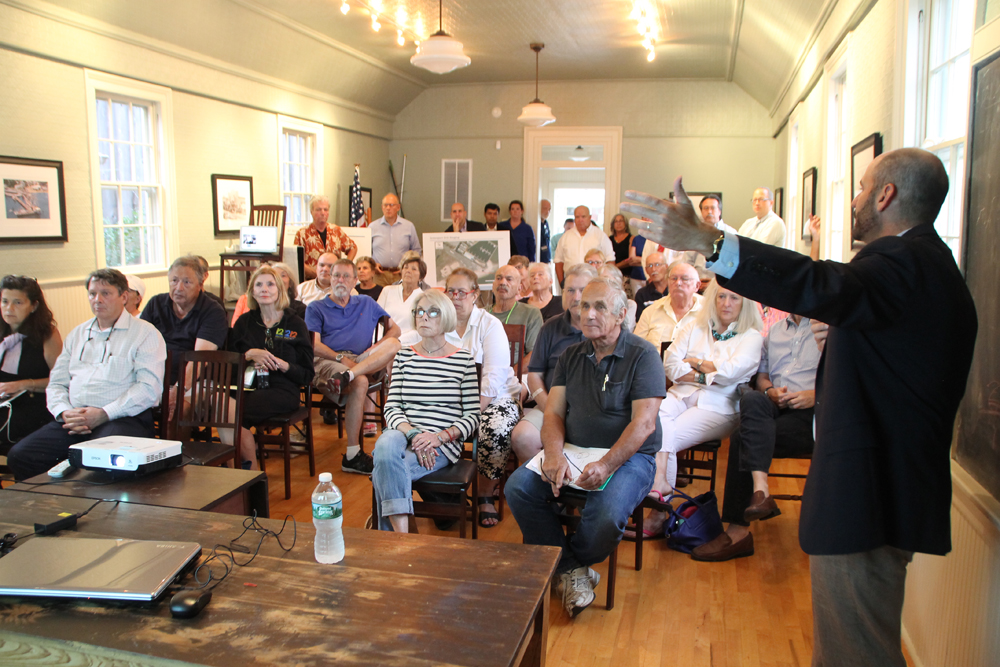PSEG fields questions, concerns from Greenporters over cable plan


As yet another Greenport resident demanded to know why the latest proposal to run an electrical cable from the North Fork to Shelter Island would succeed where the last attempt by the Long Island Power Authority had failed, Christopher Hahn, the director of external affairs for PSEG-Long Island, began to speak louder.
“I get that, I totally get that,” he said at the community meeting Tuesday evening. “We are a different company. We are not that company. We have stricter controls … I’m a senior executive of this company. We’re not going to walk away from this project.”
Despite PSEG’s assurances that the plan — which calls for laying underground electric cable through Fifth Street in Greenport and digging a 10-inch cable line under the Peconic Bay to Shelter Island — would cause “minimal disruptions” to residents, many gathered at the schoolhouse for a public forum kept asking the same question: Why us?
The answers the power company gave didn’t seem to satisfy some of the project’s harshest critics.
“It confounds us,” said Fifth Street condominium resident Chris Biemiller. “You’ve gotta be more transparent about it.”
“I think you’re wasting time and you should just take it somewhere where there’s not so many residences,” said another Fifth Street resident, Christian McShea. “You’re going right down the heart of a neighborhood.”
The roughly 90-minute long session was organized following a day of meetings between PSEG officials and residents along Fifth Street who would be affected by the construction. The forum also came less than a week after dozens of Greenport residents flooded a Village Board meeting to protest the idea.
The controversial cable proposal would give more reliable electrical service to Shelter Island, according to PSEG. A similar project was attempted by LIPA outside the village near Pipes Cove in 2013, but was eventually called off after numerous delays.
LIPA had preferred to build a substation on the island near the Shelter Island Historical Society, but vocal residents opposed that plan and the Shelter Island Town Board passed a resolution banning such construction last year.
Under the Greenport cable plan, PSEG would spend an estimated 90 days digging a conduit from the end of Fifth Street under the bay floor to Shelter Island Heights. Unlike the Pipes Cove project, this proposal calls for a quieter type of drill, which Mr. Hahn claimed would be quieter than his voice at the meeting.
The power company would then install an underground line at least 2.5 feet below Fifth Street over three weeks, according to a PSEG presentation. Mr. Hahn said the voltage used by the line is no different than the power lines used in neighborhoods across Long Island, and added that construction would move quickly down the street.
Crews would begin setting up on site at 6 a.m. for 6 days per week, work from 7 a.m. to 5 p.m. and clean up until 6 p.m., he said.
“We want to work with you,” Mr. Hahn said at the beginning of the meeting. “We want to be responsive and hopefully you’ll feel better about this project than you do right now because I know there’s a lot of misinformation out there.”
Residents at Tuesday night’s meeting peppered the PSEG representatives with questions, asking how much the project would impact the environment. Mr. Hahn and PSEG environmental expert Edward Aldrich said the company would monitor drilling closely to ensure no accidents occurred.
Mr. Hahn added that should sewer pipes or any other property become damaged, PSEG would answer claims made by the residents. The company hopes to begin work on the project later this year and have it completed by May 1, 2017.
Many of the residents’ questions focused on the financial compensation the village would get from PSEG if the project moves forward, something Mr. Hahn said he wasn’t at liberty to discuss. Some in the audience said PSEG — which is planning to spend between $28 million and $30 million on the project — should give the village more than a $1 million fee, which Village Board members had previously claimed was the latest negotiated compensation.
Others asked why other locations, like Fourth Street nearby, hadn’t been considered. While Mr. Hahn said the company would look into that location, project manager Emmanuel Lilimpakis said the Fifth Street location was the best one.
Mr. Lilimpakis said the angle of the seafloor made it easier to attempt the project there than anywhere else, and Mr. Hahn said various other obstacles would have to be avoided at other locations.
“You see the obstacles in this room,” Mr. Biemiller replied.
Village Board members had stayed away from Tuesday’s meeting due to state open government laws that would require a public notice before the board gathers at a publicly held meeting, announced Village Trustee Doug Roberts before the forum began. Mr. Roberts said the board was listening through a livestream and would review the meeting again before the board’s own meeting Thursday.
Mr. Roberts asked members of the public to attend that meeting as well, saying it was important for the board to hear their opinions and concerns about the project.
“Come and let us have it,” Mr. Roberts said. “That’s the beauty of this. We sit there twice a month. You can come up, speak to us and tell us what you think.”
Mr. Roberts added that the Village Board was not planning to vote on the proposal at Thursday’s meeting.








